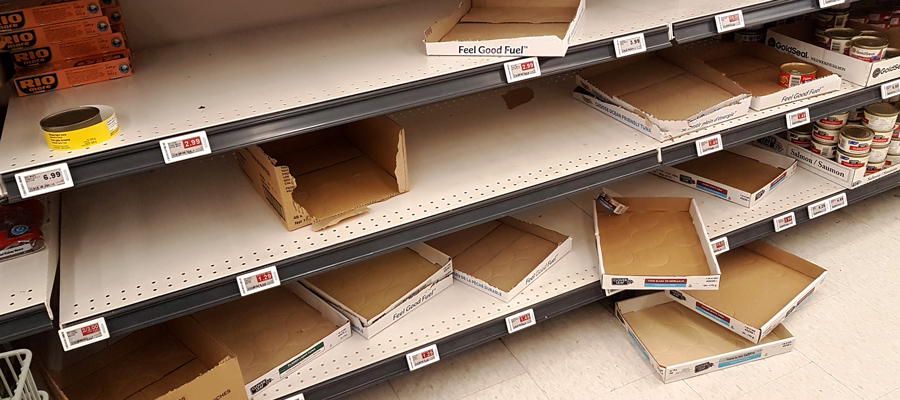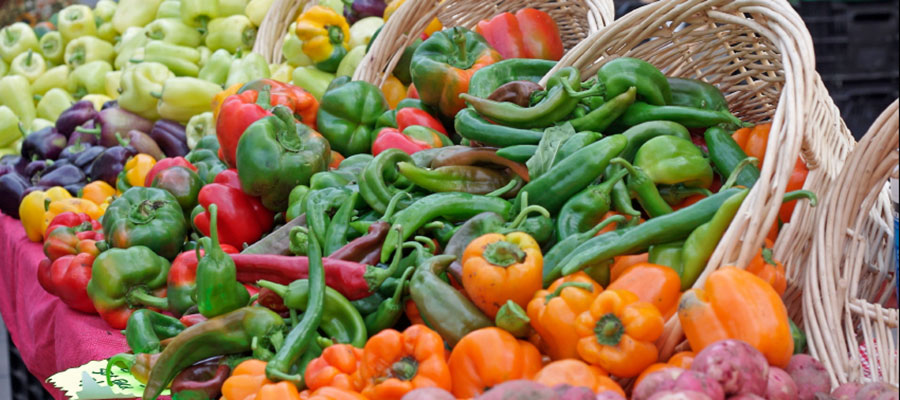Food insecurity and hunger during COVID-19

The COVID-19 pandemic has exposed holes in our social safety net and significant inequality across BC households. Much of the recent focus has been on workers facing unemployment and renters unable to pay for their housing, with new federal and provincial supports enacted to try to address these needs.
In this post I want to look more closely at food insecurity and hunger, and the need to develop a more resilient food system in BC. Two important gaps must be filled: on the demand side, a lack of income to buy food, leaves low-income people vulnerable to price spikes and food shortages; and, on the supply side, the lack of protection/support for our local food producers, who are all the more important with the potential disruption of global food supply chains, especially for fruits and vegetables imported from California.
While more affluent households would likely be able to meet their needs, food price spikes would hit hardest for the most vulnerable members of our society
Pictures of empty shelves in supermarkets due to panic buying and hoarding behaviour are particularly dire. Food supply shortages and price spikes are far from implausible depending on how severe the crisis hits at home and abroad. BC imports half of its fruit and vegetables, raising questions about the province’s ability to feed itself if supply disruptions were to take place. Grocery store prices are already starting to rise.
While more affluent households would likely be able to meet their needs, food price spikes would hit hardest for the most vulnerable members of our society, who do not have the financial capacity to bulk-purchase food and could face much higher food prices due to shortages.
Thankfully, the BC government has now stepped in to ban the resale of food and other essential supplies, and to restrict quantities of items purchased at the point of sale to prevent hoarding. The BC government has also stepped in with an emergency $3 million for food banks to deal with a surge in demand during the crisis. And it has announced a temporary supplement of $300 per month (for the next three months) for people on income and disability assistance who don’t qualify for federal emergency benefits.
BC should build a more food secure province during the crisis, and after the crisis lifts.
Active monitoring of food prices to prevent profiteering and gouging should also be on the government’s radar. Ideally this should be part of a more coordinated plan to reinforce local food supply chains into the summer and fall. Establishing resilient local food supply chains beyond farmers markets should be a priority, and could include a central market distribution system that pays fair wages back to farmers along with basic environmental sustainability criteria.
BC should build a more food secure province during the crisis, and after the crisis lifts. According to the Community Nutritionists Council of BC, food security “exists when all community residents obtain a safe, personally acceptable, nutritious diet through a sustainable food system that maximizes healthy choices, community self-reliance and equal access for everyone.”
Ironically, the BC government’s Food Security Task Force, which reported in January of this year, does not even scratch the surface of food security, broadly defined. It fails to address hunger and local food connections in favour of moving deeper into a strategy of expanding BC’s agricultural exports with a lot of hand-waving about using technology to improve competitiveness and efficiency. In the COVID-19 context, the emphasis of the Food Security Task force on high-tech initiatives that don’t actually feed people is striking.
As we build out of COVID-19, deepening connections with local BC agriculture can be a win-win for a more secure food system overall. BC could be much more food self-sufficient with a more coordinated approach, including investment in local food processing and networks, as well as supporting farmers. (My colleagues look at some of the justice considerations for migrant farm workers in this post.)
Food system advocates emphasize having adequate income as central to combating hunger and achieving food security.
On the demand side, prior to COVID-19 BC’s food system was already characterized by hunger and food insecurity. A recent report found that in 2017/18, 555,700 people (12.4% of BC households) experienced some level of food insecurity in the previous year. About one-quarter of this group (143,400 people, 3.2% of households) were considered severely food insecure.
Food insecurity is worse in households with children and worst of all in single parent households. Other vulnerable people include Indigenous communities, recent immigrants, seniors, the homeless, injection drug users, and people with disabilities or suffering from diseases.
Food banks represent the front line in responses to food insecurity. BC food banks reported 124,713 visits in 2019, of which 38,000 were from children. More than half had social assistance or disability assistance as their main source of income.
Food system advocates emphasize having adequate income as central to combating hunger and achieving food security. The existence of food banks is testament to the lack of income for many. Earning a living wage—$19.50 per hour in Metro Vancouver—is essential in this regard, but the collapse of paid work is the central challenge of COVID-19.
The gaps revealed by the COVID-19 pandemic point to an opportunity for a more equitable and healthier food system.
Much energy has been put into developing new income supports for people who have lost work and income due to the pandemic, but comparably little has gone towards supporting the poorest households in BC. The federal government will be providing one-time bonus payments for the GST credit ($400 for singles, $600 per couple) and child benefits ($300 per child), while the BC government is increasing the climate action tax credit in July for a one-time increase of $174 per adult and $51 per child.
The gaps revealed by the COVID-19 pandemic point to an opportunity for a more equitable and healthier food system. People on social assistance represent more than half of food bank usage. Indeed, insufficient welfare rates were cited as the number one reason for accessing a food bank. Improving incomes across the poorest households is therefore a key component of meaningfully addressing food security in BC.
When not fighting pandemics, the British Columbia Centre for Disease Control estimates the cost of a nutritious diet for BC households. For example, they estimated the cost of a nutritious diet (in 2017) at $517 per month for a single-parent household. By comparison, BC’s inadequate social assistance provides only $526 in the (non-shelter) support rate for single parent households—which is supposed to pay for all costs other than rent, food, clothing, toiletries, transit, etc. The cost of a nutritious basket for a family of four was $1,019 per month, several hundred dollars higher than the support rates provided under social assistance.
A more holistic and systems approach to BC’s food system should guide our planning for the post-coronavirus period, not a return to technological pipe dreams.
The BC government’s additional (and temporary) $300 per month for people on income and disability assistance is both welcome and not enough in the context of ridiculously starting points. Income support for the non-employed is severely inadequate, and must reflect the costs of food and other basic goods and services—that is, dramatically increased.
COVID-19 is prompting a rethink of many things we took for granted just a few weeks ago. In the area of food there is a large opportunity to be grasped, one that reflects a vision promoted by food organizations in nutrition, hunger, sustainable agriculture and local food. A more holistic and systems approach to BC’s food system should guide our planning for the post-coronavirus period, not a return to technological pipe dreams.
Topics: COVID-19, Economy, Poverty, inequality & welfare, Provincial budget & finance


